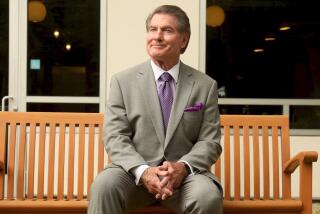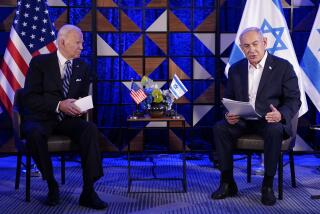PLURALISM : Coexistence in Israel Nurtured by U.S. Fund
JERUSALEM â Can Jews and Arabs live in peace in the Middle East?
The immediate test is not in relations between Israel and Syria, says Haifa University sociology professor Eugene Weiner, nor even in those between Israel and the Palestinians. Instead, he sees it resting in the harmony between Israelâs Jewish majority and its Arab minority.
And the answer is yes, Weiner says, although that Jewish-Arab coexistence, even after 45 years, is sometimes fractious and does need nurturing.
While the numbers are often limited, Israelâs Arabs and Jews do go to school together, get medical treatment at the same hospitals, tackle social problems such as drug addiction in alliance and, increasingly, search for other ways to enhance their relationship.
âWe already have coexistence and cooperation between Jew and Arab in Israel,â Weiner said. âThe scale is not so small--20% of Israelâs population is Arab, a minority larger than African-Americans in the U.S.--and the relationship has an everyday presence with its own strength and rhythm.â
To expand the interaction between Israelâs 4.2 million Jews and 1 million Arabs, Weiner works with a small, 4-year-old American foundation, the Abraham Fund, to finance projects that foster âdemocracy, tolerance, pluralism and coexistence--and that recognize that we live here together.â
Alan B. Slifka, a New York financier who serves as the fundâs president, said that Israelis, both Jews and Arabs living within the countryâs pre-1967 borders, have âdeveloped enormous skills and experience at coexistence that can be applied to the region as a whole and--donât laugh--exported to other parts of the world too.â
Slifkaâs logic is straightforward: Let Israelâs Jewish majority see that its experience living with Israeli Arabs can be extended to the Palestinian Arabs of the occupied West Bank and Gaza Strip and to Syria, Lebanon and Jordan.
This year, the Abraham Fund--named for the biblical patriarch revered by Jews, Muslims and Christians--is giving initial grants totaling $473,500 to 34 programs that promote Jewish-Arab cooperation and channeling direct grants of a further $110,000.
Some programs bring Jewish and Arab children together in camps, in preschool centers, on nature outings and in teen groups. Others attempt to ensure Arabs equal access to health and social services and education.
Others train community leaders committed to working with one another; one such Jerusalem program looks toward the day when the city might be both an Israeli and a Palestinian capital.
In the million-dollar terms that Israel usually measures gifts from the United States, the amounts are not large--the average grant is $14,000, and some are as small as $5,000--but Slifka and Weiner are confident of their impact.
âWe look for add-on and for leverage,â Slifka said. âMany Israeli programs would promote coexistence if only they had that little bit of money they need for a language teacher or to translate some materials or to train some more volunteers. Other programs have the capacity to grow much, much bigger if a pilot effort succeeds. For us, small is beautiful.â
Slifka is beginning a fund-raising effort in the United States next week that would allow the Abraham Fund to finance many more projects.
âIf we could put $5 million a year in here, it would have enormous impact,â he said, âfor it would affect Arab attitudes to Israel across the whole Middle East by demonstrating the ability of Jews and Arabs to coexist. . . . We hope for support from people who want to see different headlines from Israel.â
Despite these intentions, the Abraham Fund has drawn some criticism from those who see Israel as a Jewish state and the Arab minority as an unfortunate historical circumstance; there are also some fears of competition with larger, more traditional fund-raising efforts.
âOf all the money that goes to Israel each year, nothing specifically goes to fund coexistence between Jews and Arabs here, though it is clear the Arabs are here to stay and a major fact of life,â Slifka said. âAnd, while some of these programs could use 25 times as much money, our goals are more modest.
âWe feel that the only antidote for the pressure of terrorism, of fundamentalism and of fear is a large number of people sharing the experience of coexistence and training others in that experience--because, quite simply, it is the only alternative to unceasing armed confrontation and conflict.â
More to Read
Sign up for Essential California
The most important California stories and recommendations in your inbox every morning.
You may occasionally receive promotional content from the Los Angeles Times.










